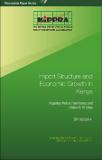| dc.description.abstract | Imports are fundamental for the survival of a small open economy such as Kenya.
Various trade reforms have been implemented to achieve several objectives
including raising revenue, maintaining favourable balance of payment,
and protecting import substituting industries. In this paper, import demand
function for Kenya (1975 to 2011) is estimated to assess the major determinants
of imports. An error correction model was adopted. The results show Kenya
imports are significantly determined by real GDP, real exchange rate, foreign
reserves and trade openness. In the short run, import demand is sensitive to real
exchange rate, foreign reserves, and trade openness. The statistical significance
of the lagged error correction term suggests imports and its determinants are
co-integrated, hence have long run equilibrium. When a Granger causality test
is estimated, the results show a unidirectional causality from real GDP to real
imports. The paper, therefore, proposes enactment of policies that discourage
importation for direct consumption. | en |

